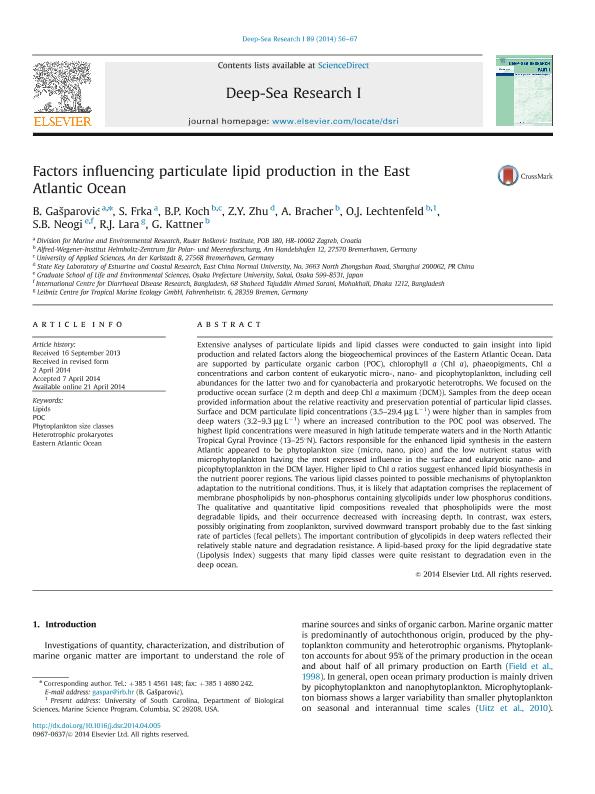Artículo
Influential factors for the particulate lipid production in the East Atlantic Ocean
Gašparović, B.; Frka, S.; Koch, B. P.; Zhu, Z. Y.; Bracher, A.; Lechtenfeld, O. J.; Neogi, Sucharit Basu; Lara, Ruben Jose ; Kattner, G.
; Kattner, G.
 ; Kattner, G.
; Kattner, G.
Fecha de publicación:
04/2014
Editorial:
Elsevier
Revista:
Deep Sea Research Part I: Oceanographic Research Papers
ISSN:
0967-0637
Idioma:
Inglés
Tipo de recurso:
Artículo publicado
Clasificación temática:
Resumen
Extensive analyses of particulate lipids and lipid classes were conducted to gain insight into lipid production and related factors along the biogeochemical provinces of the Eastern Atlantic Ocean. Data are supported by particulate organic carbon (POC), chlorophyll a (Chl a), phaeopigments, Chl a concentrations and carbon content of eukaryotic micro-, nano- and picophytoplankton, including cell abundances for the latter two and for cyanobacteria and prokaryotic heterotrophs. We focused on the productive ocean surface (2 m depth and deep Chl a maximum (DCM)). Samples from the deep ocean provided information about the relative reactivity and preservation potential of particular lipid classes. Surface and DCM particulate lipid concentrations (3.5–29.4 μg L−1) were higher than in samples from deep waters (3.2–9.3 μg L−1) where an increased contribution to the POC pool was observed. The highest lipid concentrations were measured in high latitude temperate waters and in the North Atlantic Tropical Gyral Province (13–25°N). Factors responsible for the enhanced lipid synthesis in the eastern Atlantic appeared to be phytoplankton size (micro, nano, pico) and the low nutrient status with microphytoplankton having the most expressed influence in the surface and eukaryotic nano- and picophytoplankton in the DCM layer. Higher lipid to Chl a ratios suggest enhanced lipid biosynthesis in the nutrient poorer regions. The various lipid classes pointed to possible mechanisms of phytoplankton adaptation to the nutritional conditions. Thus, it is likely that adaptation comprises the replacement of membrane phospholipids by non-phosphorus containing glycolipids under low phosphorus conditions. The qualitative and quantitative lipid compositions revealed that phospholipids were the most degradable lipids, and their occurrence decreased with increasing depth. In contrast, wax esters, possibly originating from zooplankton, survived downward transport probably due to the fast sinking rate of particles (fecal pellets). The important contribution of glycolipids in deep waters reflected their relatively stable nature and degradation resistance. A lipid-based proxy for the lipid degradative state (Lipolysis Index) suggests that many lipid classes were quite resistant to degradation even in the deep ocean.
Palabras clave:
Atlantic Ocean
,
Organic Matter
,
Lipids
,
Phytoplankton
Archivos asociados
Licencia
Identificadores
Colecciones
Articulos(IADO)
Articulos de INST.ARG.DE OCEANOGRAFIA (I)
Articulos de INST.ARG.DE OCEANOGRAFIA (I)
Citación
Gašparović, B.; Frka, S.; Koch, B. P.; Zhu, Z. Y.; Bracher, A.; et al.; Influential factors for the particulate lipid production in the East Atlantic Ocean; Elsevier; Deep Sea Research Part I: Oceanographic Research Papers; 89; 4-2014; 56-67
Compartir
Altmétricas



